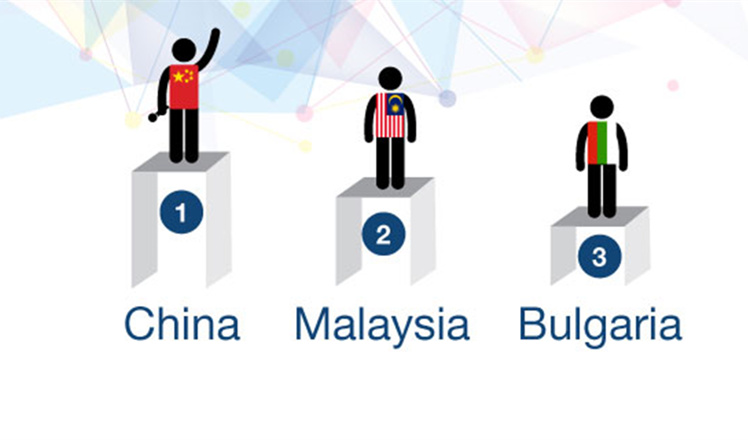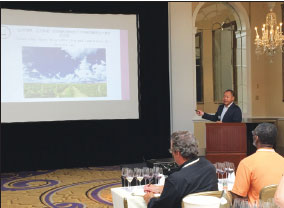Chinese wines greet the world
Updated: 2016-08-16 10:51
By Dong Leshuo in Washington(China Daily USA)
|
|||||||||
|
Cao Kailong, deputy director of the General Office of the Administrative Committee of the Grape Industry Zone of Helan Mountain's East Foothill Wine Region, talks about the wine industry in Ningxia at the Society of Wine Educators' 40th Annual Conference, in Washington on Aug 13. Dong Leshuo / China Daily |
"China is an important producer, and increasingly an important consumer," said Edward Korry, president of the Society of Wine Educators (SWE). "I think as educators it's really important to know what is going on in the whole world so that we don't get disconnected from any part of it."
Korry was speaking at the SWE's 40th annual conference in Washington on Aug 13.
"I've also tasted wine from other vineyards in other parts of China, but I don't think other regions quite have the ability to cross the border and have this uniqueness," he said of Ningxia.
With the minority Hui people making up about a third of the population, Ningxia lies about 500 miles west of Beijing. The wine grapes are planted in the north of Ningxia, in the foothills of the Helan Mountains.
Grapes have been grown in Ningxia for more than 1,300 years, but it's not until recently that people have been starting to get to know the wines from the region, according to Cao Kailong, deputy director of the administrative committee of the Grape Industry's Helan Mountains east region, who spoke as a special guest at the conference.

In 2012, Ningxia became the first province or region in China to be accepted as an official observer at the International Organization of Vine and Wine (OIV).
The only other OIV observer in China is Yantai, in East China's Shandong province, which is at a municipal level.
"The local government has realized the potential and opportunities for Ningxia wines and has been making a lot of effort to help Ningxia wines develop," Cao said.
By the end of 2015, there were 35,000 hectares of wine grapes among a total 40,000 hectares of grapes in Ningxia.
Ningxia is planning to establish a 67,000-hectare vineyard, a vine and wine cultural center, three ecological wine culture cities, 10 vine-and-wine-themed towns and more than 100 quality wineries by 2020, according to Cao.
After tasting the nine wines that were brought from Ningxia, wine writer and educator Laura Lee-Chin said the Sha Po Tou Cabernet Gernischt was her favorite.
"It's fascinating to me," she said. "It's got a lot of promise. I think it's the one that you can develop even further, it is so distinctive."
"Ningxia has some uniqueness, but it has more connectivity to the style of wine that we currently find in some parts of California, or in Washington state," said Korry. "I think it will take time for this kind of uniqueness to express itself, but stylistically, it leans more to the new world right now."
Currently, the Ningxia Winemakers Challenge (NWC) is being carried out in the region. The project funds about 50 winemakers from around the world to practice their craft in Ningxia for two years. Each of them will make 10,000 bottles of wine and each winemaker will be entitled to approximately 2,000 bottles of the wine that he or she makes. The winner will be awarded a prize. Seven of the 50 winemakers are from the US, according to Cao.
Nignxia and the SWE are planning more collaborations.
leshuodong@chinadailyusa.com
- Malaysian authorities say ship carrying diesel hijacked
- Army commander: THAAD would 'easily affect' China-US ties
- Twin panda cubs confirmed born in Vienna zoo
- Four killed in boat collision in Greece
- Premier Li to receive Aung San Suu Kyi
- S Korean president names 3 new ministers for partial reshuffle

 China edges Brazil in volleyball quarterfinals
China edges Brazil in volleyball quarterfinals
 China's women's table tennis team sweeps gold
China's women's table tennis team sweeps gold
 Artists build sand sculptures to greet upcoming G20
Artists build sand sculptures to greet upcoming G20
 Top 10 biggest auto makers of 2015
Top 10 biggest auto makers of 2015
 British dad turns breakfast into work of art
British dad turns breakfast into work of art
 China inches up Global Innovation Index 2016
China inches up Global Innovation Index 2016
 Female soldiers on Frigate Jingzhou
Female soldiers on Frigate Jingzhou
 Synchronized swimming duo advances into final
Synchronized swimming duo advances into final
Most Viewed
Editor's Picks

|

|

|

|

|

|
Today's Top News
Trump outlines anti-terror plan, proposing extreme vetting for immigrants
Phelps puts spotlight on cupping
US launches airstrikes against IS targets in Libya's Sirte
Ministry slams US-Korean THAAD deployment
Two police officers shot at protest in Dallas
Abe's blame game reveals his policies failing to get results
Ending wildlife trafficking must be policy priority in Asia
Effects of supply-side reform take time to be seen
US Weekly

|

|










